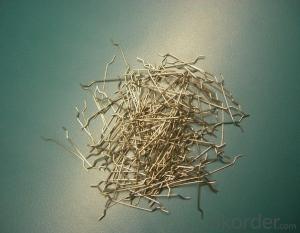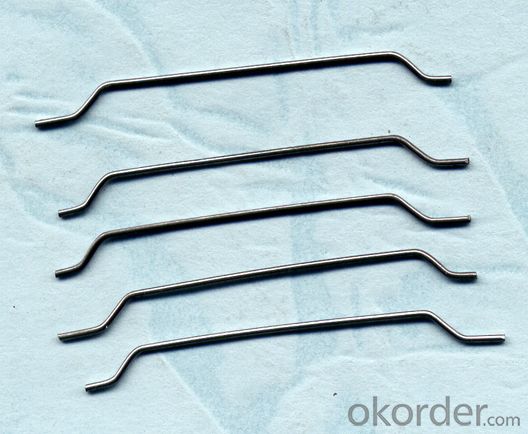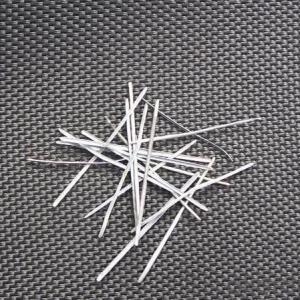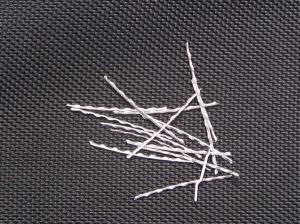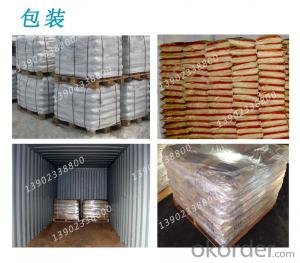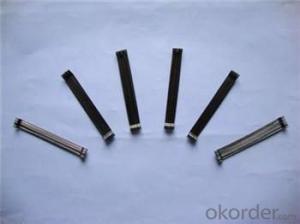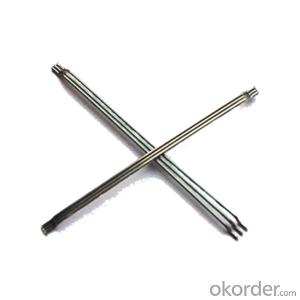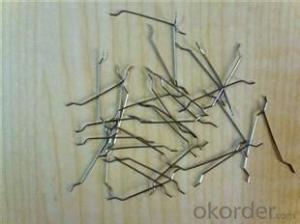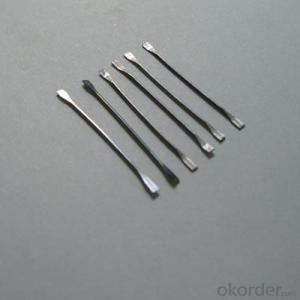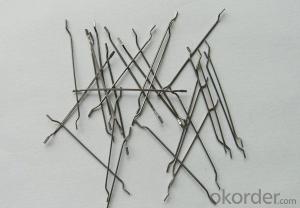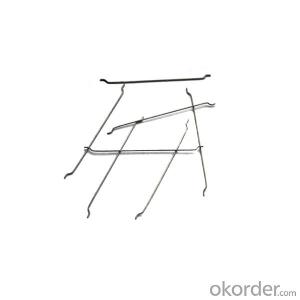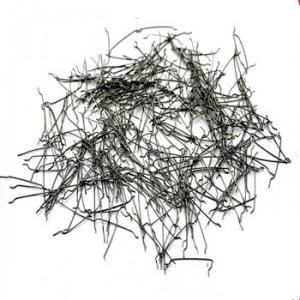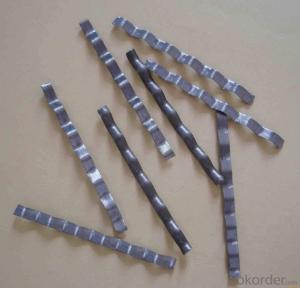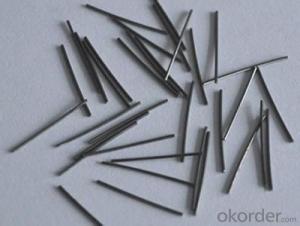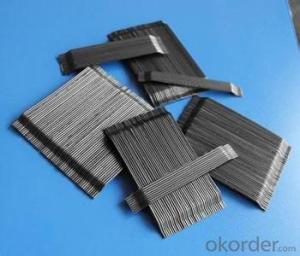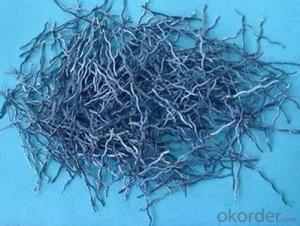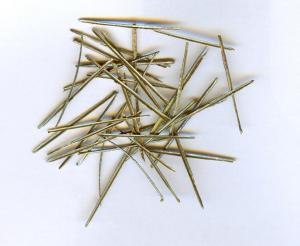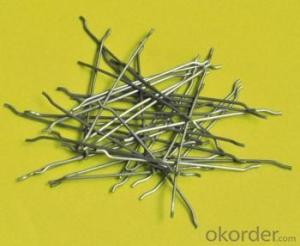Melt Extract Stainless Steel Fiber Reinforced Concrete with 1100MPA Tensile Strength
- Loading Port:
- Tianjin
- Payment Terms:
- TT OR LC
- Min Order Qty:
- 1000 kg
- Supply Capability:
- 250000 kg/month
OKorder Service Pledge
OKorder Financial Service
You Might Also Like
Quick Details
Place of Origin: Shandong, China (Mainland), Shandong, China (Mainland)
Material: Steel
material: steel wire
shape: corrugated round fiber
appearance: clean and bright
usage: construction and concrete
Model Number: steel fiber
Product features
steel iber for concrete reinforcement ,it`s widely used in buildings ,bridges ,thin roof engineering ,highway etc
cncrete steel iber is specificially designed to enhance concrete in its hardened state ,the uniform distribution of steel fibers throughout the concrete greatly improves concrete bonding and tensile strength ,additionally it provides exceptional load stability and durability ,as reliable and efficient concrete reinforcement material .
it is widely used in buildings ,bridges ,thin roof engineering ,highway etc.
Specifications
Material: round cold drawn wire
Wire diameter: 1.0mm+-0.05mm
Fiber length: 60mm
Fiber diameter: 0.75mm
Tensile strength: ≥1100Mpa
Elongation at break: < 4%
Appearance:bright and clean wire
Package and storage
20KG or 25kg/damp-proof poly and paper composite bag. 50 bags or 40 bags/pallet.
The pallets should be protected against rain and snow.
Product standard
EN14889-1type1(cold drawn wire)
SATM A820/A820M-04type1(cold drawn wire)
Features and benefits(comparing with common concrete)
Tensile Strength (%) | Against pressure (%) | Against shear (%) | against bending (%) | Against impact (%) | Against fatigue (%) | Wear resistance(%) |
50-70 | 8-10 | 50-100 | 120-180 | 200-700 | 50-60 | 25-35 |
Picture
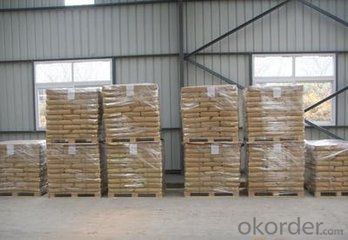
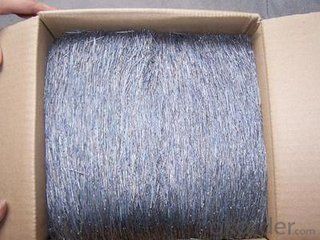
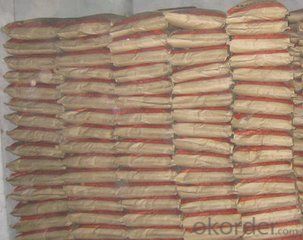
steel fiber for concrete reinforcement
FAQ
we can produce any type steel fiber and of course we can make production according to your requirement
we have specilize in this field for almost 10 years ,with good quality and competitive price
cncrete steel iber is specificially designed to enhance concrete in its hardened state ,the uniform distribution of steel fibers throughout the concrete greatly improves concrete bonding and tensile strength ,additionally it provides exceptional load stability and durability ,as reliable and efficient concrete reinforcement material .
- Q: Are there any guidelines or standards for using melt extract stainless steel fiber in construction?
- Yes, there are guidelines and standards for using melt extract stainless steel fiber in construction. These guidelines provide recommendations for the appropriate dosage, distribution, and mixing of the fiber in concrete or mortar, as well as guidance on the design and construction of fiber-reinforced concrete structures. Additionally, there are standards that specify the mechanical properties, dimensions, and testing requirements for melt extract stainless steel fibers used in construction applications. Following these guidelines and standards ensures the safe and effective use of melt extract stainless steel fiber in construction projects.
- Q: What is the lifespan of melt extract stainless steel fiber in concrete?
- The lifespan of melt extract stainless steel fiber in concrete can vary depending on various factors such as the quality of the fiber, the specific application, and the environmental conditions. Generally, melt extract stainless steel fibers have a long lifespan and are known for their durability and resistance to corrosion. In normal concrete conditions, the lifespan of melt extract stainless steel fiber can range from 20 to 50 years. This is due to the high tensile strength and corrosion resistance of stainless steel, which allows it to withstand the harsh conditions in concrete such as exposure to moisture, chemicals, and temperature changes. However, it is important to note that the lifespan can be affected by factors such as the quality of the fiber itself, the concrete mix design, and the maintenance and care of the concrete structure. Proper installation and curing methods, as well as regular maintenance and inspection, can significantly extend the lifespan of the stainless steel fiber in concrete. It is also worth mentioning that the specific application of the concrete, such as heavy traffic areas or exposure to extreme weather conditions, can impact the lifespan of the stainless steel fiber. In these cases, additional measures such as surface coatings or sealants may be necessary to further protect the stainless steel fiber and enhance its longevity. Overall, melt extract stainless steel fiber is a reliable and durable reinforcement material for concrete structures, and with proper care and maintenance, it can provide a long lifespan of 20 to 50 years or even more.
- Q: What is the difference between melt extract stainless steel fiber and other types of steel fibers?
- Melt extracted stainless steel fiber, also referred to as melt extract steel fiber, is produced by melting stainless steel and then swiftly drawing it into fine fibers. This manufacturing process yields fibers with distinct properties and characteristics compared to alternative steel fibers. An important distinction of melt extract stainless steel fiber from other varieties is its improved resistance to corrosion. Stainless steel is renowned for its capacity to withstand corrosion and oxidation, rendering melt extract stainless steel fibers highly impervious to rust and degradation over time. Consequently, they are suitable for use in environments prone to exposure to moisture, chemicals, or other corrosive substances. Another distinction lies in the heightened tensile strength of melt extract stainless steel fibers. The expedited extraction process aligns the steel molecules, resulting in fibers that are more robust and durable than their counterparts. This augmented tensile strength makes melt extract stainless steel fibers optimal for reinforcing concrete or other materials that necessitate high strength and durability. Additionally, melt extract stainless steel fibers exhibit exceptional thermal and electrical conductivity. This attribute makes them suitable for applications requiring efficient heat or electricity transfer. For instance, they can be employed in heating elements, electromagnetic shielding, or as conductive reinforcement in composites. Lastly, melt extract stainless steel fibers possess a smoother surface compared to other steel fibers. This smooth surface promotes improved bonding with the surrounding matrix, such as concrete or resin, leading to enhanced load transfer and overall performance. Furthermore, the smoothness reduces the likelihood of fiber pull-out or breakage, further enhancing their effectiveness as reinforcement materials. In conclusion, melt extract stainless steel fibers distinguish themselves from alternative steel fibers due to their enhanced corrosion resistance, increased tensile strength, exceptional thermal and electrical conductivity, and smoother surface. These distinctive properties render them a preferred choice for various applications requiring high-performance reinforcement materials.
- Q: What is the recommended testing procedure for melt extract stainless steel fiber in concrete?
- To effectively test the melt extract stainless steel fiber in concrete, the following steps are recommended: 1. Prepare a representative sample of the concrete mixture, ensuring that the fiber content aligns with the desired dosage for the actual application. 2. Achieve uniform distribution of the stainless steel fibers throughout the concrete mixture by thoroughly mixing the sample. This can be done either using a concrete mixer or by hand mixing. 3. Pour the mixed concrete into the designated mold or testing apparatus, making sure that the mold is adequately prepared and cleaned to avoid any interference with the test results. 4. Allow the concrete specimen to cure under controlled conditions for a specified time period. This involves maintaining a consistent temperature and humidity level to promote proper hydration and strength development. 5. Once the concrete has sufficiently cured, conduct the necessary tests to assess the performance of the melt extract stainless steel fiber. Common tests include evaluating compressive strength, flexural strength, and toughness. 6. Analyze the test results to determine how effectively the melt extract stainless steel fiber enhances the mechanical properties of the concrete. Compare the results with those of a control group without fiber reinforcement to evaluate the impact of the fiber on the concrete's performance. 7. Document the testing procedures, results, and any pertinent observations in a comprehensive report. Include details such as fiber dosage, curing conditions, and test methodologies to ensure reproducibility. It is important to recognize that the specific testing procedure may vary depending on the intended application and project requirements. Consulting relevant standards, guidelines, or industry best practices can provide more specific recommendations for testing melt extract stainless steel fiber in concrete.
- Q: How does melt extract stainless steel fiber affect the permeability of concrete?
- Melt extract stainless steel fibers have a significant impact on the permeability of concrete. These fibers are thin, elongated strands that are added to concrete mixtures during the mixing process. When properly dispersed throughout the concrete, they create a three-dimensional network that enhances the overall durability and performance of the concrete. One of the main benefits of adding stainless steel fibers is the reduction in concrete permeability. Concrete is naturally a porous material, allowing liquid and gas to pass through it. However, the addition of stainless steel fibers helps to close these pores and reduce the permeability of the concrete. The melt extract stainless steel fibers act as a physical barrier, preventing the passage of water, chemicals, and other harmful substances into the concrete. This is particularly important in environments where the concrete is exposed to harsh conditions, such as marine or industrial applications. By reducing the permeability of concrete, the addition of stainless steel fibers also improves its resistance to corrosion and deterioration. This is because the fibers help to limit the ingress of moisture and aggressive agents that can cause the reinforcement steel within the concrete to corrode. As a result, the lifespan of the concrete structure is extended, and maintenance costs are minimized. Furthermore, the reduced permeability of concrete with stainless steel fibers also enhances its resistance to freeze-thaw cycles. When water enters the concrete and freezes, it expands, causing internal pressure and leading to cracking and deterioration. The presence of stainless steel fibers helps to restrict the entry of water, thereby reducing the potential for freeze-thaw damage. In summary, melt extract stainless steel fibers have a positive impact on the permeability of concrete. They reduce the passage of water and other harmful substances, enhancing the durability, resistance to corrosion, and resistance to freeze-thaw cycles of the concrete. By improving these properties, stainless steel fibers contribute to the overall performance and longevity of concrete structures.
- Q: Can melt extract stainless steel fiber be used in high-strength concrete?
- Yes, melt extract stainless steel fiber can be used in high-strength concrete. Stainless steel fiber reinforcement is commonly used in high-strength concrete to enhance its mechanical properties and improve its durability. The melt extract stainless steel fibers, which are produced by melting stainless steel and then extracting the fibers, offer several advantages for high-strength concrete. These fibers have high tensile strength, excellent corrosion resistance, and good bonding properties with the concrete matrix. They can effectively control cracking and increase the flexural and compressive strength of the concrete. Additionally, the use of melt extract stainless steel fibers can improve the resistance of high-strength concrete to impact, fatigue, and fire. Overall, melt extract stainless steel fiber is a suitable reinforcement material for high-strength concrete applications.
- Q: What is the effect of melt extract stainless steel fiber on the carbonation resistance of concrete?
- The melt extract stainless steel fiber has a positive effect on the carbonation resistance of concrete. It helps to improve the durability and longevity of concrete structures by reducing the rate at which carbon dioxide can penetrate into the concrete and react with the alkaline components, thereby reducing the risk of carbonation-induced corrosion.
- Q: What is the cost-effectiveness of using melt extract stainless steel fiber?
- The cost-effectiveness of melt extract stainless steel fiber usage relies on various factors, including the specific application, desired performance, and overall project requirements. One of the main advantages of melt extract stainless steel fiber is its durability and ability to strengthen and enhance the durability of concrete and other composite materials. By incorporating stainless steel fibers, the overall structural integrity and resistance to cracking and shrinkage can be greatly improved. This leads to longer-lasting structures, reduced maintenance costs, and increased safety. Moreover, melt extract stainless steel fibers exhibit excellent corrosion resistance properties, making them suitable for harsh environments or exposure to chemicals. This further extends the lifespan of structures and reduces the need for frequent repairs or replacements. Nevertheless, it is crucial to consider the initial cost of using melt extract stainless steel fiber, as it may be higher than traditional reinforcement methods. The cost of the fiber itself and the installation process should be taken into account. Additionally, the overall project budget needs to be evaluated to determine if the long-term benefits outweigh the initial investment. Furthermore, the cost-effectiveness of this fiber type depends on specific project requirements and performance expectations. For instance, in situations involving heavy loads, high temperatures, or extreme conditions, the usage of melt extract stainless steel fiber may prove more cost-effective in the long run, as it provides enhanced performance and durability compared to other reinforcement materials. Ultimately, a comprehensive evaluation of the specific project requirements, performance expectations, and long-term benefits is necessary to assess the cost-effectiveness of melt extract stainless steel fiber usage. Seeking advice from experts in the field, such as structural engineers or material specialists, can provide valuable insights and help determine the most cost-effective solution for a given application.
- Q: Can melt extract stainless steel fiber be used in precast concrete beams or columns?
- Precast concrete beams or columns can indeed utilize melt extract stainless steel fiber. It is a popular choice for reinforcing concrete structures because of its exceptional strength and durability. By incorporating stainless steel fiber, the flexural and tensile strength of precast concrete beams and columns can be significantly improved, resulting in greater resistance to cracking and overall performance enhancement. Moreover, stainless steel fibers possess outstanding resistance to corrosion, making them highly suitable for environments where concrete structures are subjected to moisture or chemicals. Ultimately, the utilization of melt extract stainless steel fiber in precast concrete beams or columns contributes to their prolonged lifespan and enhanced structural integrity.
- Q: Can melt extract stainless steel fiber be used in concrete bridge decks?
- Concrete bridge decks can indeed utilize melt extract stainless steel fiber. Stainless steel fibers are frequently employed as reinforcement in concrete structures, such as bridge decks, as they enhance the concrete's overall strength and durability. By doing so, they increase its resistance to cracking and improve its load-bearing capacity. Melt extract stainless steel fibers are particularly renowned for their exceptional tensile strength and corrosion resistance, which renders them an ideal selection for bridge decks that are exposed to severe environmental conditions. Moreover, these fibers aid in managing shrinkage and preventing crack formation, thereby improving the long-term performance and extending the service life of bridge decks. Consequently, melt extract stainless steel fiber represents a suitable and advantageous reinforcement alternative for concrete bridge decks.
Send your message to us
Melt Extract Stainless Steel Fiber Reinforced Concrete with 1100MPA Tensile Strength
- Loading Port:
- Tianjin
- Payment Terms:
- TT OR LC
- Min Order Qty:
- 1000 kg
- Supply Capability:
- 250000 kg/month
OKorder Service Pledge
OKorder Financial Service
Similar products
Hot products
Hot Searches
Related keywords
